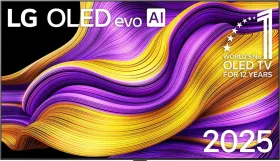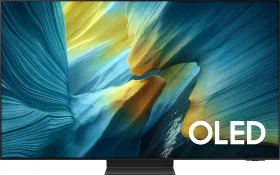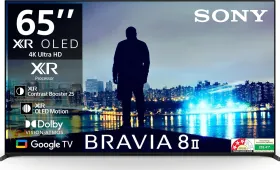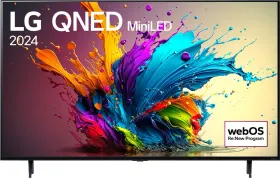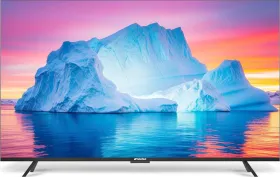Buying a premium television can be arduous, especially when you want the best bang for your buck. It’s a tough choice between the LG G5 OLED AI TV and the Sony Bravia 9, as both models are the best televisions by their respective companies. However, if you look closely, you’ll realize that there are multiple differences between the two, including display technology, features, operating system, audio output, and connectivity options.
To help you make an informed decision, here’s a detailed comparison between the LG OLED Evo AI G5 and Sony Bravia 9.
LG OLED Evo AI G5 vs. Sony Bravia 9: Design
LG OLED Evo AI G5

Dimensions (55-inch): 48.1″ x 27.7″ x 1.1″
Weight (55-inch): 16.7 kilograms
In terms of design, the LG OLED Evo AI G5 features a sleek frame with surprisingly thin bezels around the panel. Globally, the TV comes in two models: one with a wall mount and the other with a pedestal desktop stand; this allows buyers to choose their preferred configuration.
The back of the panel is where the connectivity ports are, facing downwards and sideways. You also get a cable management setup (if you opt for the variant with a stand). The television set now has an updated Magic Remote, which is slimmer, features fewer buttons, and retains the beloved motion-based gestures.
Sony Bravia 9

Dimensions (65-inch): 56.87″ x 32.87″ x 1.93″
Weight (65-inch): 32.4 kilograms
If there’s one thing that all the Sony Bravia 9 reviews mention, it’s how heavy the frame is. Being a flagship set, this one also ships with super narrow bezels. The back panel features the iconic checkerboard design as well. It is worth noting that the Bravia 9 is significantly thicker than the LG OLED Evo AI G5.
Regarding inputs, they are situated on the left side of the TV (from the front). While there are plastic covers for hiding the input section, users can also run the cables through the TV’s metallic feet. The remote that ships with the flagship television has a matte finish, features backlighting, and supports voice control.
Also Read: Most Innovative Smart TVs In 2025: Watch Out For These Models From Panasonic, LG, Samsung, And More
LG OLED Evo AI G5 vs. Sony Bravia 9: Display
LG OLED Evo AI G5

The LG G5 features an OLED panel with 8.3 million self-lit pixels (with pixel dimming technology) that produce true blacks (which results in near-perfect contrast), giving it an edge over LED-based panels. Unlike its predecessor, which featured a microlens array, the TV features a Primary RGB Tandem OLED panel.
Despite having an OLED panel, the LG G5 offers over 2000 nits of HDR peak brightness, which is among the best in the segment. The 4K screen provides 3840 x 2160 pixels and supports Dolby Vision, HDR10, and HLG formats. While these formats might be enough for several users, some might miss the HDR10+ or DTS support; Dolby Atmos is supported.
Though the television has a native refresh rate of up to 120Hz, it can go all the way up to 165Hz while gaming (as part of the Variable Refresh Rate feature). The LG G5 is also compatible with Nvidia G-Sync and AMD FreeSync Premium technology. For those wondering, the LG OLED Evo G5 has a response time of 0.1ms, which is great.
Sony Bravia 9

Unlike the OLED panel on the LG G5, the Sony Bravia 9 has a Quantum Dot panel (which consists of semiconductor nanocrystals that produce colors) with mini-LED backlighting technology. Reviews suggest that the Bravia 9 does an excellent job of producing deep blacks, but they aren’t as accurate as those of an OLED panel.
However, the Bravia 9 takes it back with higher peak brightness levels. Since it features an LCD panel, the television produces higher brightness, which leads to better visibility in brighter scenarios. Since they feature different display technology, it is best to try out these televisions in an experience center and experiment with the available brightness setting.
The Sony Bravia 9 has a 4K resolution (3840 x 2160 pixels) and supports HDR10, HLG, and Dolby Vision formats. What’s good is that Sony has included support for DTS Digital Surround, Dolby Atmos, and Dolby Audio.
Regarding refresh rate, though, Sony’s flagship television supports 120Hz in the standard mode and goes up to 144Hz in the variable refresh rate mode. Typically, Sony doesn’t include VRR certifications like those from Nvidia and AMD, and that’s true for the Bravia 9 as well. Per reviews, the TV has a slightly higher response time than the LG G5.
LG OLED Evo AI G5 vs. Sony Bravia 9: Audio

We couldn’t find details about the LG OLED Evo AI G5’s speaker system, but it most likely has four main downward-firing speakers (4.2 channel with two subwoofers) that produce an output of 60W. The LG G5 offers the WOW Orchestra feature, automatically synchronizing the audio levels between the LG TV and LG Soundbar.
On the other hand, the Sony Bravia 9 has an eight-speaker setup (2.2.2 channel) that generates an output of 70W. Though both televisions support Dolby Atmos, the Bravia 9 is considered among the best-sounding televisions in the market. Thanks to the Acoustic Multi-Audio+ feature, the television creates an effect of the sound coming directly from the TV’s screen.
Both the televisions provide eARC via HDMI 2.1.
Also Read: LG launches world’s first fully wireless and transparent OLED TV globally: Price, Specs
LG OLED Evo AI G5 vs. Sony Bravia 9: Processor And User Interface
LG OLED Evo AI G5

Under the hood, the LG G5 features the Alpha 11 AI Processor 4K Gen2, which unlocks features like AI Picture Pro (which enhances the picture quality), AI Super Upscaling (which upscales low-resolution content to 4K), and AI Director Processing (with the colors intended by the filmmakers).
The television runs on webOS 25, which provides an easy-to-use user interface. Besides, it offers features like AI Sound Mode, AI Art Generator, improvements to voice search, and a refreshed home hub design. It is a courtesy of the operating system that the television can run several OTT and infotainment apps, and it supports Apple AirPlay2, Amazon Alexa, and Google Assistant.
Sony Bravia 9

On the other hand, the Sony Bravia 9 features the XR processor, which has a scene recognition system that detects and analyzes data and then optimizes the picture for ultimate realism. It enables features like XR Clear Image (which upscales images to near 4K), XR Motion Clarity (which analyzes movement and synchronizes the backlight), and Voice Zoom (which recognizes human dialogue and amplifies it).
The television runs on Google TV and provides a vast library of entertainment and infotainment apps courtesy of the Google Play Store. It offers features like a dedicated sports hub, a section of free live TV channels, built-in Chromecast, a redesigned home panel, AI-generated screensavers, and support for Apple Airplay.
LG OLED Evo AI G5 vs. Sony Bravia 9: Connectivity Options


Connectivity options on the LG G5 include four HDMI 2.1 ports (with support for 4K @ 120 fps, eARC, VRR, ALLM, QMS, and QFT), two USB-A ports, a Digital Audio Out port, a LAN port, an RS-232C port, IR IN, and a cable/antenna input. Wireless connectivity options include Bluetooth v5.3 and Wi-Fi 6e.
The Sony Bravia 9 also offers four HDMI inputs, two of which support HDMI 2.1 standard (4k @ 120 fps, eARC, VRR, ALMM, and SBTM). However, VRR is only available for the third and the fourth HDMI ports. Then, there are two USB ports, RF inputs, one IF input, and one digital audio output. Unlike the LG G5 OLED TV, the Bravia 9 doesn’t come with an RS-232C port.
Wireless connectivity options on the Brabia 9 include dual-band Wi-Fi and Bluetooth v5.3.
Also Read: Consumer Electronics Show (CES) 2025 Roundup: Here’s What We Can Expect from the Event
LG OLED evo AI G5 vs Sony Bravia 9: Price And Conclusion
Both the LG G5 OLED TV and the Sony Bravia 9 mini-LED TV are excellent home entertainment solutions with various features. However, since they rely on different screen technologies, we strongly recommend trying out the televisions before purchasing them.
LG OLED Evo AI G5

Objectively speaking, the LG G5 OLED TV should offer better contrast, produce richer colors, and retain higher global brightness (thanks to the tandem OLED technology). If you’ve been using an LG smart TV for a while, it shouldn’t take much time to explore all the new features included in webOS 25.
Further, the television offers a higher refresh rate, lower response time, and has all four HDMI 2.1 ports, which gaming enthusiasts might prefer. However, LG hasn’t released the G5 lineup in India yet. Hence, we’d have to wait for the prices and confirmation of availability.
For reference, the LG G4 debuted in India last year. It was priced at Rs. 2,39,990 for the entry-level 55-inch variant. The 65-inch variant is currently available at Croma for Rs. 2,64,990. If we’re to speculate, the successor should launch around Rs. 3,00,000 in India (and if that happens, it will be the more affordable option between the two).
Sony Bravia 9

In contrast, the Sony Bravia 9 should provide a better viewing experience in brighter areas, like offices and open living rooms. Even though it features mini LED backlighting, the overall picture quality and viewing experience should be great. However, it supports a lesser refresh rate and has a slightly higher response time than the LG G5 OLED.
Complementing the screen is an eight-speaker system with the Acoustic Multi Audio+ feature that delivers exceptional sound. If you’re familiar with Google TV, it shouldn’t take long for you to set up the TV. Last but not least, the Bravia 9 offers Chromecast built-in, which might be a plus point for those who rely on the technology.
The 75-inch variant of the Sony Bravia 9 is listed on Sony’s official website for Rs. 6,49,900. However, you can get it at third-party retailers like Reliance Digital for as low as Rs. 4,09,191.
You can follow Smartprix on Twitter, Facebook, Instagram, and Google News. Visit smartprix.com for the latest tech and auto news, reviews, and guides.















